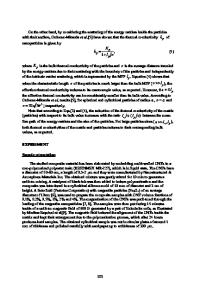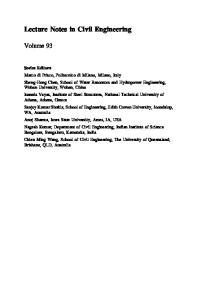Modification of cementitious composites with graphene oxide and carbon nanotubes
- PDF / 2,257,032 Bytes
- 16 Pages / 595.276 x 790.866 pts Page_size
- 19 Downloads / 431 Views
Modification of cementitious composites with graphene oxide and carbon nanotubes Jianqing Gong1 · Li Lin1 · Sujie Fan1 Received: 2 May 2020 / Accepted: 27 August 2020 © Springer Nature Switzerland AG 2020
Abstract Both graphene oxide (GO) and carbon nanotubes (CNTs) are carbon-based nanomaterials. Due to their favorable dispersibility in water and excellent mechanical properties, they are potential additives for use as reinforcements in cementitious composites. In this laboratory study, GO and CNTs were simultaneously used as additives to improve the mechanical properties (e.g., compressive strength) and durability (e.g., frost resistance, water impermeability) of cementitious composites. To maintain and optimize the mortar fluidity, fly ash (20% by the mass of the cementitious materials) was also added into the cementitious composite. Based on the laboratory test results, the compressive strength of the cementitious composite was maximized to 43.50 MPa with an optimal dosage of 0.08% GO, by weight of the total mixture. Addition of 0.04% GO (by total mixture weight) and higher dosages of up to 0.08% exhibited a strengthening effect on the cement composites due to the simultaneous bridging effect of 0.15% CNTs and the nucleation effect of GO. Furthermore, the addition of GO and CNTs contributed to improving the freeze–thawing resistance and impermeability of the cementitious composites. Overall, the study results indicated that the addition of GO and CNTs could potentially improve the mechanical properties and durability of cementitious composites, which could be very beneficial for various industrial applications such as concrete roads or building constructions. Keywords Graphene oxide (GO) · Carbon nanotubes (CNTs) · Cementitious composites · Compressive strength · Freeze– thawing resistance · Impermeability · Durability
1 Introduction Cement-based concrete is widely used for various civil engineering applications (i.e., buildings, roads, etc.), the properties of which are predominantly determined through strength characterization. Other properties such as impermeability, freeze–thawing resistance, are partially dependent on and affected by the concrete strength. The pore structure is an important factor affecting the strength of the cementitious composites and one key challenge is often how to modify the pore structure and consequently, improve the strength of the cement composite [1, 2].
It is reported in the literature that the strength of cementitious composites can be improved by adding high-efficient water-reducers to reduce the water-cement ratio, improve the workability of the cement-matrix composites, and reduce porosity [3]. These water-reducers improved the mechanical properties and durability of cementitious composites to a certain extent by optimizing the composition and structure of materials from different levels. At present, these water-reducers are mainly used to develop the cementitious composites with high compressive strength and good rheology by using the compact packing principle and mi
Data Loading...











